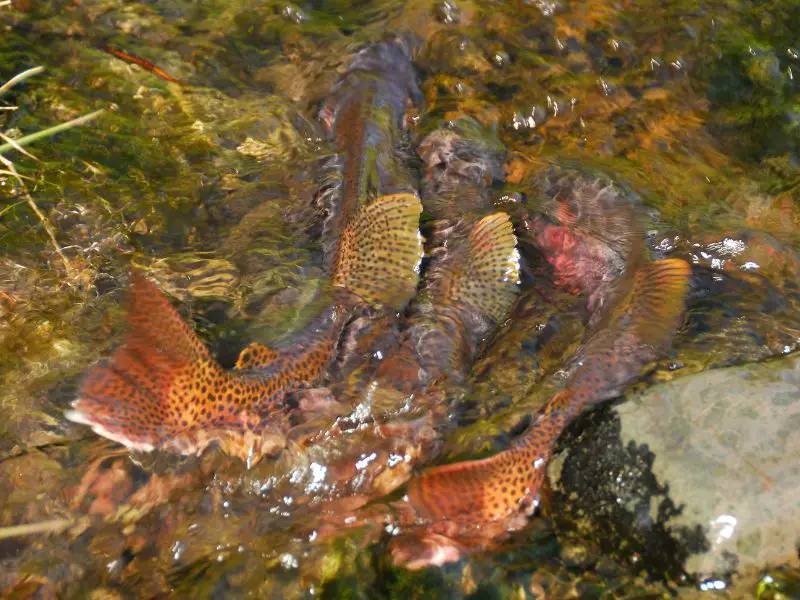I was wondering if trout die after spawning like salmon do, so I did some more research. Here’s what I found.
Up to 65% of trout can die after spawning due to the physical strain of reproduction, as well as predation or other environmental factors. However, most trout are able to successfully spawn and go on to live up to 5-10 years. The likelihood of death after spawning vary between different types of trout.
Let’s take a look at why trout die and more about their spawning behaviors.

Why Do Trout Die?
- Disease: Like all animals, trout can fall victim to various diseases and parasites. These can range from bacterial infections to viral diseases, and can be caused by a variety of factors such as poor water quality, overcrowding, and stress.
- Predation: Trout are prey for a variety of animals, including birds, mammals, and other fish. Larger predatory fish, such as pike and bass, can pose a threat to trout, especially when they are young and vulnerable.
- Environmental factors: Trout are sensitive to changes in their environment, and can be impacted by factors such as water temperature, pH, and dissolved oxygen levels. Trout can also be affected by natural disasters such as floods and droughts, which can alter their habitat and disrupt their breeding and feeding patterns.
- Poor water quality: Trout are sensitive to changes in water quality, and can be adversely affected by high levels of pollution, low oxygen levels, and extreme temperature fluctuations.
- Human impacts: Trout can also be affected by human activities, such as pollution, habitat destruction, and overfishing. If there is too much pressure on a trout population, the fish may not have enough resources to sustain themselves, leading to a decline in their numbers.
When Do Trout Spawn?
In general, trout spawn in the spring or early summer, when water temperatures begin to rise and there is an abundance of food available.
The exact timing of spawning can also be influenced by factors such as latitude, altitude, and the presence of suitable spawning habitat. For example, some trout species that live in colder climates may spawn later in the year, while those in warmer climates may begin spawning earlier.
It is also important to note that not all trout species reproduce in the same way, and some may exhibit different reproductive behaviors. Some trout species may spawn multiple times throughout the year, while others may only spawn once.
How Many Eggs Can a Trout Produce?
Trout can lay hundreds or even thousands of eggs in a single spawning season. For example, a female rainbow trout (Oncorhynchus mykiss) can lay between 500 and 2,000 eggs in a single spawning event, while a female brook trout (Salvelinus fontinalis) can lay between 200 and 1,000 eggs.
The number of eggs produced by a trout can vary depending on the size and age of the fish, as well as the species. In general, larger and older trout tend to produce more eggs than smaller or younger fish.
It is also important to note that the number of eggs produced by a trout can be influenced by environmental factors, such as water temperature and quality, as well as the availability of food. Poor environmental conditions or a lack of food can result in smaller clutches of eggs.
How Do Trouts Mate?
Trout typically mate in the spring or early summer when the water temperatures are warmer. The male trout will select a suitable spawning site, such as a gravel bed or a depression in the stream bed, and will begin to court females by displaying their colors and vibrating their bodies.
When a female trout is receptive, she will move closer to the male and release her eggs as the male releases his sperm, or milt, over the eggs to fertilize them. The fertilized eggs will then be left to develop on their own in the spawning site.
Trout can also reproduce through a process called “virgin spawning,” in which females can produce eggs without the presence of a male. This can occur when there are not enough males present, or when females are unable to find a suitable mate. In these cases, the eggs will not be fertilized and will not hatch.
It’s important to note that fishing and other human activities can impact the ability of trout to reproduce successfully. It’s important to follow local fishing regulations and to practice catch-and-release fishing to help preserve trout populations.
Which Trout Are Found In Each State?
| State | Trout Type |
|---|---|
| Alabama | Rainbow trout, brown trout |
| Alaska | Arctic char, Dolly Varden, rainbow trout, cutthroat trout, steelhead |
| Arizona | Rainbow trout, brown trout |
| Arkansas | Rainbow trout |
| California | Rainbow trout, brown trout, brook trout, cutthroat trout, steelhead |
| Colorado | Rainbow trout, brown trout, brook trout, cutthroat trout, golden trout |
| Connecticut | Rainbow trout, brown trout, brook trout |
| Delaware | Rainbow trout |
| Florida | Rainbow trout |
| Georgia | Rainbow trout |
| Hawaii | Rainbow trout |
| Idaho | Rainbow trout, cutthroat trout, brook trout, brown trout, steelhead |
| Illinois | Rainbow trout, brown trout, brook trout |
| Indiana | Rainbow trout, brown trout |
| Iowa | Rainbow trout, brown trout, brook trout |
| Kansas | Rainbow trout |
| Kentucky | Rainbow trout, brown trout |
| Louisiana | Rainbow trout |
| Maine | Rainbow trout, brook trout, brown trout |
| Maryland | Rainbow trout, brown trout, brook trout |
| Massachusetts | Rainbow trout, brown trout, brook trout |
| Michigan | Rainbow trout, brown trout, brook trout, steelhead |
| Minnesota | Rainbow trout, brown trout, brook trout, steelhead |
| Mississippi | Rainbow trout |
| Missouri | Rainbow trout, brown trout |
| Montana | Rainbow trout, cutthroat trout, brook trout, brown trout, golden trout |
| Nebraska | Rainbow trout |
| Nevada | Rainbow trout, brown trout |
| New Hampshire | Rainbow trout, brown trout, brook trout |
| New Jersey | Rainbow trout, brown trout, brook trout |
| New Mexico | Rainbow trout, brown trout |
| New York | Rainbow trout, brown trout, brook trout |
| North Carolina | Rainbow trout, brown trout, brook trout |
| North Dakota | Rainbow trout, brown trout, brook trout |
| Ohio | Rainbow trout, brown trout |
| Oklahoma | Rainbow trout |
| Oregon | Rainbow trout, cutthroat trout, brook trout, brown trout, steelhead |
| Pennsylvania | Rainbow trout, brown trout, brook trout |
| Rhode Island | Rainbow trout, brown trout, brook trout |
| South Carolina | Rainbow trout |
| South Dakota | Rainbow trout, brown trout, brook trout |
| Tennessee | Rainbow trout, brown trout |
| Texas | Rainbow trout |
| Utah | Rainbow trout, cutthroat trout, brook trout, brown trout |
| Vermont | Rainbow trout, brown trout, brook trout |
| Virginia | Rainbow trout, brown trout, brook trout |
| Washington | Rainbow trout, cutthroat trout, brook trout, brown trout, steelhead |
| West Virginia | Rainbow trout, brown trout |
| Wisconsin | Rainbow trout, brown trout, brook trout |
| Wyoming | Rainbow trout, cutthroat trout, brook trout, brown trout, golden trout |
Recommended: Can Trout Live in a Pond? Size, Food, & More
It’s worth noting that the availability of specific types of trout may vary within each state, as the distribution of trout species can be influenced by a variety of factors such as habitat, water quality, and local management practices.
Additionally, some states may stock certain types of trout in their waters to enhance recreational fishing opportunities.
